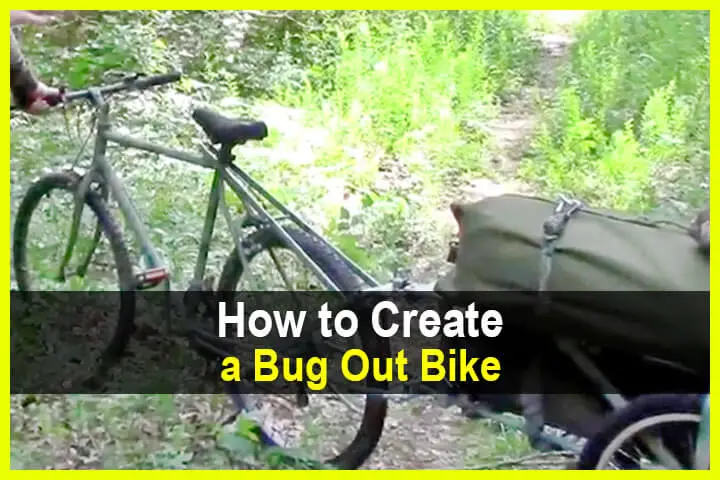Estimated reading time: 17 minutes
If you’ve done any amount of research on the subject of bug outs or evacuations in general, you’re aware of the consistent concerns about traffic jams during a panicked evacuation. The common expression defines highways as parking lots as accidents and people running out of gas stop all traffic cold.
Bugging out on foot is sometimes recommended as an alternative, but its slow going and you can only take what you can carry or drag behind you in a wagon or cart. It’s one of the reasons so many photos of wandering refugees show someone pushing a baby buggy loaded with clothes and blankets.
But there’s another possibility that requires some planning and preparation and that’s bugging out on a bicycle.
Want to save this post for later? Click Here to Pin It On Pinterest!
Bike Bug Out Benefits

In many countries around the world a bike is the most common form of transportation for many people. This seems to be particularly true in Asia. The fundamental benefit is that a bike can get you somewhere faster than walking and there’s no need for fuel or the cost of an expensive vehicle.
The challenge is that you can be limited with how much you can transport with you, but there are many clever solutions that can make bikes as effective as pack mules for transporting things.

The greatest benefit is that it can get you somewhere faster than walking when the roads are jammed or compromised by natural disasters. Bikes can go off road and off the beaten path to keep you going. It also helps that they don’t need gas at a time that may present a lot of challenges with fuel availability.
And it case you’re concerned about it –they are impervious to EMP’s.
The Downside

It seems like there’s always a downside but compared to a vehicle a bike has some obvious limitations:
- You won’t be protected from the elements like you would be in a vehicle.
- It may be harder to quickly flee a dangerous or threatening situation on a bike rather than in a car.
- If you’re not in good physical condition or haven’t done any training for long-distance biking you may be limited by how far you can go on any given day.
- Adding saddlebags and bike buggies can help you transport more gear in addition to other add-ons, but what happens when you get to that steep hill?
- Like everything, bikes break and if you’re not prepared for repairs you’ll end up bugging out on foot.
- Families bugging out on bikes versus a vehicle can be a challenge depending on the age and health of the family members.
Then again, cars break down and sometimes run out of gas so there’s the usual downside to everything.
What Kind of Bike is Best?

If you have no options and the need to bug out without a vehicle catches you buy surprise – any bike will do. However, if you have the time to plan and prepare there are some considerations for choosing or upgrading a bike for a bug out. Like all things a lot depends on your situation and your location.
- If you are bugging out from a rural or wilderness area you’ll need to consider the ability of your bike to handle rough roads and terrain. Mountain bikes make a lot of sense and can handle good roads as well as rough trails. The tires are a big consideration and we’ll cover that in detail in a bit.
- If you’re bugging out from a city location a good all-purpose bike will keep you going assuming your destination is not some remote, wilderness location. Any bug out bike should have multiple gears to help you over and up hills and you may want to say no to those skinny racing tires, but once again we’ll cover that more in a bit.
- What you pay should be based on what you can afford. Some bikes run well into the thousands but bikes in the lower hundreds are often just as good for most people. If your prepping and preparing for multiple things you have to prioritize and a reconditioned bike from a bike shop, or an upgraded old bike in the garage can get you to a better bike for less.
It’s Not Just About the Bike
No matter how you bug out there’s a good chance you’re going to have to spend a night or two or more on the road. Best case scenario and you find a hotel. Worst case you’re sleeping under the stars.
A vehicle always gives you the option of sleeping in the vehicle but with a bike you’re either camping or spending a night in an abandoned building or a shelter if there are no rooms available at a roadside motel. That means you’ll need some camping equipment, food, water and more than a few other items to survive on the road.
Hauling all of that stuff is a real challenge on a bike especially if you assume you’ll just wear a large backpack. Hiking backpacks are a bad idea on bike. They’ll shift your balance, put excess strain on your back, resist the wind and wear you out after just a few miles. Here are some good bike options for transporting gear and everything else.
Bike Saddlebags

Bike saddlebags may be the best all-purpose option. Their location on the rear wheel will help you stay balanced assuming both sides of the packs are equally weighted with gear. You can also easily lift the saddlebags off with a handle and bring them with you when you stop to spend a night somewhere.
Make sure they’re waterproof or you can even give them extra protection with a waterproofing spray.
Handlebar Compartment

Handlebar compartments tend to be smaller to fit squarely on the front of your bike. Many have a mounting bracket on top for a cell phone that you can use to navigate with a map app or GPS. They give you easy access to snacks, water, sunglasses or anything else you might need while you’re riding.
Middle Rail Compartment

There are also middle rail compartments that sometimes have a mount for a cell phone. They also can hold things you might need while you’re riding and are another way to carry some gear while keeping a balanced load on the bike.
Water Bottle Clamp

Riding a bike over any distance requires some exertion and you’ll always need to stay hydrated. There are water bottle holders designed for various parts of a bicycle usually on the seat post or middle bar. If there’s room for a water bottle holder, attach it and more than one is not a bad idea. Insulated, metal water bottles might also be a good idea.
Bike Seat Compartment

There was a time when tidy, little bike seat bags were always attached to a bike seat. You might want to think about a compartment that can hold a bit more than those bags from the past. This is where bike tools and equipment for repairs were usually stored and that’s still a good idea.
Bike Buggy

If you think you are bugging out for any duration beyond 3 days you’re going to need more equipment and gear. A bike buggy can let you load up but you’ll always have the downside of having to rely on more pedal power to keep moving.
This can also be a good idea if you’re bugging out as a family on bikes. Kids may struggle with too much equipment on a bike and mom or dad can compensate by adding the kid’s gear and clothing to a bike buggy. This is also the best way to transport bulkier gear like tents, blankets, and anything else that won’t fit into a saddlebag or those other compartments.
Solar Bike Lights

It’s not a great idea to travel at night but it can happen. Solar rechargeable bike lights are the way to go. They recharge while you ride and whenever you stop as long as the sun is shining.
The Camelback

While a large backpack could be a bad idea there’s one type of backpack worth considering. It’s the Camelback. It has some small pockets but most importantly it’s a large water bladder that will hold up to 3 liters or about a gallon and a half of water. It has a tube so you can sip while riding but it’s also a great water reservoir for anytime you’re thirsty.
It’s a compact design that fits snugly to your back and won’t impede balance or aerodynamics while you ride.
Is All of This Stuff Necessary?
Hopefully not. Ideally you pick and choose what you add on to the bike based on your needs and situation. Then again, if you’re in great shape and live in a part of the country with fairly level land you might make it with a fully loaded bike and all of these add-ons. Unless you consider a relatively new possibility: the eBike.
The eBike Option

eBikes are battery powered bikes. They have a small, electric motor on the rear wheel and a long battery running the length of the center support. They average 50 to 75 miles on a charge, can be switched off and the bike pedaled, or put into reserve mode so they only turn on when a hill or increased torque on the pedals is detected. At that point the motor automatically kicks in to get you over that hill.
Some can reach speeds up to 28 mph and small solar panels can be used to recharge the batteries when you stop or even while you’re riding. They’re not cheap running from $400 to more than $3,000.
The good news is that they can make a bike a viable bug out option for people who are not physically fit or elderly and can make things a lot easier for kids as well. They also make it easier to load and haul a lot of gear. The only problem with equipping the whole family with eBikes is the cumulative cost of multiple eBikes.
The bad news is that they’re heavy and if the battery dies and you’re left to pedal while pulling a bike buggy and other add-ons you may not get far on any incline to say nothing of a steep hill. You could always get off and simply walk the bike for a while, but always keep your eye on the remaining battery charge.

Most have a digital display on the handle bars indication your power reserves and estimate miles remaining on epower.
And Then There’s the Tires

If there’s one thing worth investing in with any bike intended for a bug out it’s the tires. In fact, the number one repair bikers have to make even on an everyday basis are the tires. And it’s not just about the quality of the tires although that’s definitely important. It’s the type of tire.
Say No to Those Skinny Racing Tires

Many bikes come with racing tires. Replace them or buy something else. Skinny, racing tires are meant for clear, clean and level surfaces usually found on a racetrack. During a bug out there can be all manner of debris on any road and one pot hole will wipe out a racing tire.
They also tend to be treadless and are a disaster on wet or slippery roads. If your bike has them and you plan to use that bike to bug out – replace those skinny tires.
Road Tires

These are good, all-purpose tires but are generally intended for riding on paved roads. They’ll run off-road to some degree but they’re best on pavement. Think of them as the urban tires if you’re bugging out from a city on roads and parkways.
Mountain Bike Tires

Mountain bike tires are the knobby tires common on many mountain bikes. They’re designed for off-road biking and get a good grip on dirt, sand and can even make it through some amount of mud.
The downside is that while they will work on pavement just fine, they offer some amount of resistance due to the knobs on the tires.

Some people put a street tire on the front of the bike and reserve the knobby tires for the back. That’s up to you.
There are also mountain bike tires that have a smoother, tread finish on the center of the tire for road riding with knobs on the side to grip through loose dirt, soil and sand.

That might be the best compromise if you’re not sure where you might end up riding during a bug out.
And then there’s Those Fat Tires

Something that showed up recently were fat tires on bikes. You may have done a double take the first time you saw someone riding a bike with them. Here again, they work fine on paved roads although they do require a bit more energy given the amount of contact and friction with any pavement.
They first showed up on eBikes where the electric motor compensates for the extra drag caused by the wider tire width.

What’s good about them is that they work well off rode and can actually get you through mud, deep sand and even snow. They’re also good on rough terrain.
The downside is that they require a bit of muscle without an eBike and you may end up walking your bike up hills more than you want to if you have fat tires. If you have any inclination to put these on your bike, see if you can do a test ride first to see if you think they’re might be right for you.
Tire Repair Kit

Regardless of the type of tire you choose, any tire can go flat. Make sure you have a decent tire repair kit and maybe an extra tire tube or two. There’s no sense bugging out on a bike if you can’t keep it going.
And Of Course There’s More
Deciding how you bug out is only one part of the equation. There are multiple considerations related to what to pack and carry. Here are some links to some very good articles about various bug out scenarios and what to bring along with some YouTube videos about bugging out on a bike.
It’s Never Easy
An bug out decision is a challenging proposition. Leaving the safety of home and many possessions behind can’t be easy for anyone. The reasons for evacuation are usually significant enough that the potential loss of some possessions may be the least of your concerns. This is about saving your life and the lives of your family in the event of a raging disaster like an approaching wildfire or worse.
A bug out bike is an alternative worth considering. Evacuating in a vehicle is best but there are always those panicked traffic jams to think about. Maybe you buy a bike rack for the back of your vehicle and bring the bikes along, just in case. That would give you the option of evacuating in a vehicle, by bike if necessary and finally on foot if that’s what it takes. It gives you a lot of options at a time when options may be few and far between.
Like this post? Don’t Forget to Pin It On Pinterest!



















